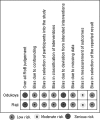Systematic review of school tobacco prevention programs in African countries from 2000 to 2016
- PMID: 29408895
- PMCID: PMC5800696
- DOI: 10.1371/journal.pone.0192489
Systematic review of school tobacco prevention programs in African countries from 2000 to 2016
Abstract
Background: The World Bank has reported that global smoking rates declined from 2000 to 2012, with the only exception found in males in Sub-Saharan Africa. Sub-Saharan Africa is considered to be in stage one of the tobacco epidemic continuum. To address this problem, school-based programs for smoking prevention are considered cost-effective and promising. Since tobacco prevention programs are influenced by social competence or customs of each country, tobacco prevention programs that have success in Western countries are not always effective in African countries. Therefore, the current study systematically reviewed relevant literature to examine the effects of these types of programs in African countries.
Method: Online bibliographic databases and a hand search were used. We included the studies that examined the impact of school-based programs on preventing tobacco use in Africa from 2000 to 2016.
Results: Six articles were selected. Four were conducted in South Africa and two were performed in Nigeria. Four programs were systematically incorporated into annual curriculums, targeting 8th to 9th graders, while the other two were temporary programs. All programs were based on the hypothesis that providing knowledge and/or social skills against smoking would be helpful. All studies utilized smoking or polydrug use rates to compare outcomes before/after intervention. There were no significant differences between intervention and control groups in three studies, with the other three demonstrating only partial effectiveness. Additionally, three studies also examined change of knowledge/attitudes towards smoking as an outcome. Two of these showed significant differences between groups.
Conclusion: All RCTs studies showed no significant change of smoking-rate by the intervention. The effectiveness of intervention was observed only in some sub-group. The cohort studies showed school-based interventions may be effective in improving knowledge and attitudes about smoking. However, they reported no significant change of smoking-rate by the intervention.
Conflict of interest statement
Figures
Similar articles
-
School-based programmes for preventing smoking.Cochrane Database Syst Rev. 2006 Jul 19;(3):CD001293. doi: 10.1002/14651858.CD001293.pub2. Cochrane Database Syst Rev. 2006. Update in: Cochrane Database Syst Rev. 2013 Apr 30;(4):CD001293. doi: 10.1002/14651858.CD001293.pub3. PMID: 16855966 Updated.
-
Heated tobacco products for smoking cessation and reducing smoking prevalence.Cochrane Database Syst Rev. 2022 Jan 6;1(1):CD013790. doi: 10.1002/14651858.CD013790.pub2. Cochrane Database Syst Rev. 2022. PMID: 34988969 Free PMC article.
-
Home treatment for mental health problems: a systematic review.Health Technol Assess. 2001;5(15):1-139. doi: 10.3310/hta5150. Health Technol Assess. 2001. PMID: 11532236
-
A rapid and systematic review of the clinical effectiveness and cost-effectiveness of paclitaxel, docetaxel, gemcitabine and vinorelbine in non-small-cell lung cancer.Health Technol Assess. 2001;5(32):1-195. doi: 10.3310/hta5320. Health Technol Assess. 2001. PMID: 12065068
-
School-based programmes for preventing smoking.Cochrane Database Syst Rev. 2002;(4):CD001293. doi: 10.1002/14651858.CD001293. Cochrane Database Syst Rev. 2002. Update in: Cochrane Database Syst Rev. 2006 Jul 19;(3):CD001293. doi: 10.1002/14651858.CD001293.pub2. PMID: 12519553 Updated.
Cited by
-
Mega-map of systematic reviews and evidence and gap maps on the interventions to improve child well-being in low- and middle-income countries.Campbell Syst Rev. 2020 Oct 28;16(4):e1116. doi: 10.1002/cl2.1116. eCollection 2020 Dec. Campbell Syst Rev. 2020. PMID: 37018457 Free PMC article.
-
Exploring smoking cessation behaviors of outpatients in outpatient clinics: Application of the transtheoretical model.Medicine (Baltimore). 2020 Jul 2;99(27):e20971. doi: 10.1097/MD.0000000000020971. Medicine (Baltimore). 2020. PMID: 32629709 Free PMC article.
-
Prevalence, trends and distribution of lifestyle cancer risk factors in Uganda: a 20-year systematic review.BMC Cancer. 2023 Apr 5;23(1):311. doi: 10.1186/s12885-023-10621-y. BMC Cancer. 2023. PMID: 37020195 Free PMC article.
-
Association between socio-economic status and non-communicable disease risk in young adults from Kenya, South Africa, and the United Kingdom.Sci Rep. 2023 Jan 13;13(1):728. doi: 10.1038/s41598-023-28013-4. Sci Rep. 2023. PMID: 36639432 Free PMC article.
-
Intervention Increases Physical Activity and Healthful Diet Among South African Adolescents Over 54 Months: A Randomized Controlled Trial.J Adolesc Health. 2019 Jul;65(1):139-146. doi: 10.1016/j.jadohealth.2019.01.027. Epub 2019 Apr 23. J Adolesc Health. 2019. PMID: 31028006 Free PMC article. Clinical Trial.
References
-
- American Cancer Society. Cancer facts and figures. 2005. Available from: http://our.cancer.org/downloads/STT/CAFF2005f4PWSecured.pdf.
-
- U.S. Department of Health and Human Services. The health consequences of smoking: a report of the surgeon general. U.S. Department of Health and Human Services, Centers for Disease Control and Prevention, Office on Smoking and Health; 2004.
-
- Eriksen M, Mackay J, Ross H. The Tobacco Atlas, Fourth Edition Atlanta Georgia: American Cancer Society, Inc.; 2012. Available from: http://tobaccoatlas.org/uploads/Images/PDFs/Tobacco_Atlas_2ndPrint.pdf.
-
- World Health Organization. Tobacco key facts. 2009. Available from: http://www.who.int/topics/tobacco/facts/en/index.html.
-
- World Health Organization. The MMPOWER package: WHO report on the global tobacco epidemic. Geneva: World Health Organization; 2008. p.1–19.
Publication types
MeSH terms
LinkOut - more resources
Full Text Sources
Other Literature Sources
Medical




